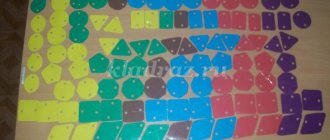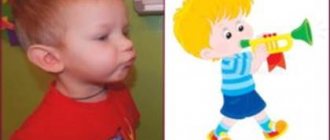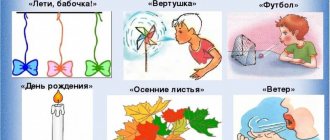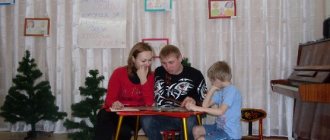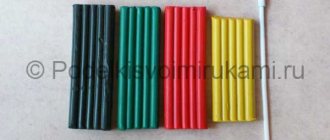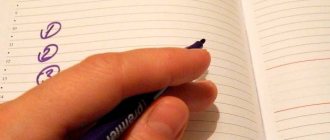Article:
When articulating the sound Zh
- lips are rounded and slightly pushed forward;
- teeth are brought together;
- the wide tip of the tongue is raised to the alveoli or to the anterior edge of the hard palate and forms a gap with it; the middle part of the back of the tongue drops, but the edges of the tongue are pressed against the lateral teeth; the back of the back of the tongue rises and pulls back;
- in the middle of the tongue there is a warm air stream, which is easily felt by the palm of the hand brought to the mouth;
- the soft palate is raised and pressed against the back wall of the pharynx, closing the passage into the nasal cavity; the air stream goes through the mouth;
- the vocal folds are tense, vibrate and give voice.
After attempting to pronounce the sound z, the speech therapist or teacher discusses the quality of the sound. If there is a discrepancy with the normalized sound, the child discusses exactly which link the error was made and the problematic operation is found on the diagram.
Reasons for incorrect pronunciation
Incorrect pronunciation of hissing and whistling sounds is called sigmatism.
The reasons why it may appear are various. The most common ones are the following:
- Features of the structure of the articulatory apparatus: shortened frenulum, “Gothic” palate (when the child has a high arch of the hard palate), structural defects of the jaw (bad bite), nasopharynx.
- Weak innervation of the tongue muscles, or, on the contrary, high muscle tone.
- Impaired phonemic awareness.
- Delay in the development of the child’s nervous system.
Problems with sound pronunciation can also appear against the background of imitating the incorrect speech of an adult. It is important that the child hears correct, clear speech not only in lessons with specialists, but also at home.
How to conduct speech therapy sessions with your child at home. Adviсe
Classes should be held in a playful way. This way the child will not be wary of them, nervous or complex.
- You cannot overly insist on exercises and force your child. Classes should bring him pleasure. Only in this case will your pronunciation quickly begin to improve.
- The lesson should not exceed 15 minutes, and articulation gymnastics (warm-up) should last at least 5 minutes. This is how the exercises will bring the greatest benefit.
- You should not repeat breathing and voice exercises more than 4-5 times. Children tire quickly, use more oxygen than usual, and may feel dizzy.
- The child should not have a cold (stuffy nose, sore throat), otherwise breathing exercises will be performed incorrectly and will not be beneficial.
- To enhance the effect of classes, it is necessary to consolidate skills throughout the day. Children will have fun playing and saying tongue twisters together with adults. You can do this both at home and on a walk.
- You can invite your child to act as a teacher. Let him “teach” his favorite toy to pronounce a letter.
- Games and exercises for fine motor skills - modeling, coloring, designing letters - will help develop speech.
- Be sure to praise your baby. It is important for him to feel his achievements.
Articulatory position of the sound Ж
The articulation of the sound Ж is similar to the position of the sound Ш, but with the only difference - in the first case it is necessary to pronounce with the addition of a voice (the ligaments are tense), otherwise the characteristics are the same:
- The lips are slightly forward, rounded, as when producing the sound O.
- The back of the tongue is raised towards the back of the upper palate.
- The tip of the tongue is directed upward towards the alveoli, located behind the front teeth.
- The side of the tongue rests on both sides of the molars.
Setting sounds [Ш], [Ф]
With correct articulation of the sounds [Ш], [Х] the parts of the articulatory apparatus occupy the following position: • lips are slightly rounded; • the teeth are either compressed or brought together, leaving only a narrow gap (about 1-2 mm); • the wide tip of the tongue is raised to the alveoli or the anterior edge of the hard palate and forms a gap with them; • the lateral edges of the tongue are pressed against the upper molars and do not allow a stream of exhaled air to pass along the sides; • in the middle of the tongue there is a warm air stream, which is easily felt by the palm of the hand brought to the mouth; • the velum palatine is raised and closes the passage into the nasal cavity; • the vocal cords are open when articulating the sound [Ш]; when articulating the sound [Х] they are closed and vibrate.
Producing sibilant sounds requires complex and subtle movements of the tongue. The following exercises help develop the necessary movements of the tongue and the direction of the air stream.
Exercises for lips “Smile”. Smile so that the upper and lower teeth are visible, and hold this position for 5-7 seconds. "Tube". Stretch your lips with a tube: 1st option - pronounce the sound [U] for a long time without using your voice; 2nd option - pull your lips slightly forward, as if forming a square; teeth are closed.
"The doors are opening." Slowly open your mouth until there is a distance of 10-15 mm between the upper and lower teeth, hold your lips in the “Smile” position. "Bunny." Smile so that your upper and lower teeth are visible, raise your upper lip (wrinkle your nose), and lower it back into place. Lower your lower lip and open your lower teeth. Lips and teeth are closed. Repeat 5-7 times.
Exercises for the “Pancake” language. Place a wide, relaxed tongue on the lower lip. Make sure that the lower lip does not tense. The upper teeth should be exposed (that is, the “Smile” position is maintained). If the tongue does not take the desired shape, it is recommended to do a passive massage, pronounce syllables with the tongue sticking out between the lips, for example: “ba-ba-ba”. Upon achieving success, make your tongue wide without pronouncing these syllables and blow with a narrow stream of air until a groove is formed along the midline of the tongue. "Delicious jam." Lick your upper lip from top to bottom with your wide tongue. "Kitty." Bend the wide tip of the tongue upward towards the nose. If this movement does not work, then you should first practice licking the upper teeth under the lip from right to left, then licking the upper lip. "Swing". Smile, show your teeth, open your mouth slightly, put your wide tongue behind your lower teeth (from the inside) and hold in this position for a count of one to five. Then lift your wide tongue by the upper teeth (also from the inside) and hold it for a count of one to five. Alternately change the position of the tongue 4-6 times. "The ball burst." Lips in the “Smile” position, the upper and lower teeth are visible, open by 10-15 mm. The wide tip of the tongue behind the upper teeth. Pronounce the sound [C] (you should get a sound reminiscent of the hissing of escaping air).
Important: The lateral edges of the tongue should be pressed against the molars, the tip of the tongue thin and mobile, the lips in the “Smile” position. If the voluntary lifting of the protruding tongue to the upper lip turns out to be unbearable, then you have to resort to mechanical assistance using a spatula. Having achieved that the child can blow with the tongue positioned at the upper lip, you can move the tongue behind the upper teeth with the mouth open. Next, the child moves his tongue to the palate, then closes his teeth and rounds his lips.
Exercises for developing the air stream “Breeze”. Blow through close lips, controlling the stream of exhaled air using a strip of paper brought to your mouth, a piece of cotton wool suspended on a thread, or simply by feeling the stream on your hand brought to your mouth.
"Put the ball into the goal." Stretch your lips forward with a tube and blow for a long time onto a cotton ball (lying on the table in front of the child), driving it between two cubes. “Who will kick the ball further?” Smile, place the wide front edge of the tongue on the lower lip, as if pronouncing the sound [F] for a long time, blow the cotton wool onto the opposite edge of the table. The lower lip should not be pulled over the lower teeth. Make sure that the child does not puff out his cheeks and pronounce the sound [F], not [X].
"Singing Bubble" The exercise is done in front of a mirror with the tongue stuck wide between the lips, its lateral edges adjacent to the corners of the mouth. A longitudinal groove should form in the middle of the tongue. Holding the vial (test tube) vertically, it should be brought with its hole to the middle part of the front edge of the tongue. If, at the moment of blowing, a groove is formed along the tongue, along which an air stream rushes, then when the bubble (test tube) is brought to the tongue, a strong noise should be heard, which indicates the correct alignment of the tongue.
"Focus". Smile, open your mouth slightly, place the wide front edge of your tongue on your upper lip so that its side edges are pressed and a groove is formed in the middle, and blow off the cotton wool placed on the tip of your nose. The air should go in the middle of the tongue, then the fleece will fly up. If the child successfully copes with all the exercises, you can begin direct sound production.
Some of the most common techniques for producing the sound [Ш] include the following: • The disadvantages of hissing sounds [Ш] and [З] can be eliminated if the whistling sounds [С] and [З] are pronounced correctly. To make the sound [Ш], the child should be asked to pronounce the sound [S] for a long time and at this time, using a spatula placed under the front edge of the tongue, lift the tongue by the upper incisors; with this position of the tongue, instead of the sound [S], you get the sound [SH], and instead of the sound [Z], you get the sound [Zh]. Gradually, the child learns independently, without the help of a spatula, to hold the tongue in the desired position and correctly pronounce the hissing sounds [Ш] and [ж].
The child should be instructed to slightly extend his lips when pronouncing these sounds (show in front of a mirror) and listen to the nature of the sound produced. You should also draw the child’s attention to the warm air stream.
When the sounds [Ш] and [Х] sound correctly in isolated form, you need to practice pronouncing them in syllables, words, phrases, and sentences. In all cases, the consonant must be pronounced protractedly.
• In cases where, along with the defective phoneme [Ш], there is a normally pronounced phoneme [Р], you can use the latter as a basis for obtaining the required articulation of the sound [Ш]. To do this, the child is encouraged to pronounce the sound [P] in front of the mirror without a voice or in a whisper. At this time, you need to lightly touch the lower surface of the tongue with a spatula and slow down the vibration of its front edge. After several exercises with mechanical assistance with the mouth open, when the ability to voluntarily reproduce the required articulation is achieved, you can move on to pronouncing the resulting sound with clenched teeth (the hissing becomes thicker, i.e. lower), and then complement the articulation by rounding the lips, which will lead to normal sound sound [III]. • The child is encouraged to pronounce the sound [P] in a drawn-out manner in front of the mirror without a voice or in a whisper, gradually reducing the force of exhalation until the vibration stops and a faint hiss is heard. After several exercises, a hissing sound is obtained without the previous pronunciation of a voiceless [P]. • The next technique is based on using the sound [T] as a base. The child is encouraged to pronounce the sound [T] several times in front of the mirror at intervals of 3-4 seconds. Then the exercises change. Articulation is reproduced not with the teeth close together, but with the mouth half-open, and it is indicated that the anterior edge of the tongue should close not with the teeth, but with the alveoli. Having achieved the goal, you should proceed to pronouncing the sound [T] at the alveoli with aspiration (as with the English sound [t]). A weak and short hissing noise is added to the sound of the explosion. This sound then lengthens and is released from the explosion that preceded it. All that remains is to move the tongue a little deeper, and later move on to clenching the teeth and, finally, to rounding the lips.
The further task is to consolidate the articulation of the sounds [SH] and [Zh] in syllables, words, etc. When automating the sounds [SH], [Zh] in words, one should take into account the child’s articulatory abilities, his age, the ability to master semantics, and mastery of syllabic structure words.
Correcting defects in the pronunciation of the sound [Zh] with acquired articulation [Ш] does not cause difficulties. The child is asked to pronounce the drawn-out sound [Ш] and turn on his voice. This is first done by the speech therapist himself, bringing one of the child’s hands to his mouth and placing the other to his throat (to feel the vibration). Important: You should follow the dosage of breathing exercises, as well as exercises related to the production and automation of sound [Ш], as they are quite tiring for the child and can cause dizziness due to hyperventilation.
Similar articles: Setting sounds [Ч], [Ш], Setting sounds [Р], [Р'].
Incorrect pronunciation of sound: types of sibilant sigmatism
Sometimes parents of a child who has problems with sound pronunciation turn to a speech therapist late for help. Or they even think that the baby has no problems with speech, due to the fact that they do not always know how this or that sound should be reproduced correctly. Each sound has its own articulatory position. By ear, it may seem that the child seems to pronounce it (doesn’t miss it or replace it, just “F” is heard), but at the same time he doesn’t always articulate it correctly.
The work is carried out individually, depending on the characteristics of the violation. There are several types of hissing sigmatism, characterized by incorrect position of the organs of the speech apparatus:
- Lower (the sound is softened).
- Rear-lingual (in this case, the position of the articulatory organs is as with the sounds G, X; this leads to the fact that the sound Z is pronounced noisily).
- Buccal (in this case, the tongue is motionless, the cheeks are puffed out, the teeth are closed, and a dull, booming sound is formed).
A small digression. Sound or letter?
Sound and letter are inseparable from each other. But often even adults confuse these concepts, not understanding the difference between them.
In fact, everything is very simple. What we speak and hear are the sounds of the Russian language. And what we see and read in a book, notebook, computer monitor are letters.
Children first learn to reproduce sounds (speak) and only then begin to write letters (denote what is said graphically).
But due to the fact that we are almost always asked the question: “How to teach a child to say the letter R or the letter Sh?”, we believe that the difference between the letter and the sound in this case is not fundamental. For ease of understanding and reading the article, we chose a single and The term “letter” is familiar to most readers.
Prevention of sound pronunciation correction and prediction
In addition to the speech therapy classes that the child attends in kindergarten or speech school, homework to eliminate speech disorders and sound correction is also recommended. Additional work with parents will help reinforce the material covered.
The teacher can invite parents to perform some exercises from a complex of articulation or breathing exercises with their child at home. If the baby still does not always correctly differentiate the sound, and in free speech replaces it with a similar sounding one, then adults are recommended to focus on this, offering the correct option.
Thus, work on correcting sound pronunciation will be carried out continuously: in the garden, on a walk, at home, which will lead to positive results.
The sooner speech therapy work begins, the sooner speech will become correct and all sounds will be brought to automatism.
Speech hearing
Correct speech of a child is achieved through speech hearing. To pronounce sounds correctly, the child must clearly perceive them by ear.
Determine the location of sounds in a word: at the beginning, middle or end of the word. Hear whether a given sound is hissing or not.
Distinguish sounds against the background of similar sounds:
- In an isolated position
- In syllables
- In words
Expert opinion
Margarita Sergeevna S.
Speech pathologist and speech pathologist with 15 years of experience working in various speech correction centers with children of different ages.
With dysarthria, the production and automation of hissing sounds becomes more complicated and requires more time and individual training.
When to seek help from a speech therapist
You shouldn’t delay going to an appointment with a speech therapist. The sooner work on your baby’s speech begins, the faster he will learn to speak beautifully and clearly. It is necessary to consult a specialist in the following cases:
- At 3-4 years old, a child cannot stretch out his lips like a tube, puff out his cheeks, stick out his tongue, touch the palate with it, or reproduce the simplest rhythm.
- After 3.5 years, the baby skips syllables in words and confuses their places.
- At 4.5 - 5 years old, a preschooler does not speak in coherent phrases and confuses gender, number and case in sentences.
- The child speaks through his nose.
- He chokes on words, unable to keep up with his thoughts.
- The baby swallows the syllables.
- He doesn't have enough breath to pronounce the phrase.
- The child speaks monotonously.
- The preschooler does not strive to communicate and discuss what he saw, heard, etc.
- Homework on incorrect pronunciation of letters does not bring the expected effect.
- The child has congenital anomalies - cleft lip, short ligament on the tongue, decreased hearing, etc.
A child’s correct speech is not formed immediately. There are age standards that determine at what age a child should be able to pronounce a particular letter.
If a child cannot pronounce a certain letter correctly, parents can teach him at home.
Correct pronunciation requires trained muscles of the lips and tongue, as well as proper breathing. Articulation and breathing exercises, as well as games and tongue twisters to consolidate the acquired skill, will help teach your child to pronounce letters correctly.
It is imperative to encourage and praise your child for his successes. Seeing the support of adults and the effect of the work done, the child will enjoy the classes. And this is the key to a good result. This way the baby will learn to correctly pronounce even such complex letters as R, Ш, Ж, Л, С.
If you liked the article, please share a link to it
